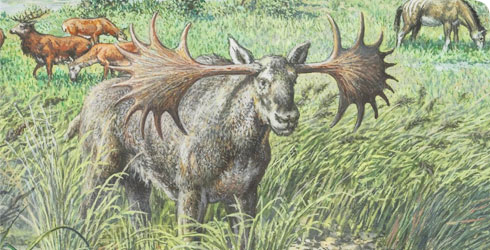Cervalces latifrons
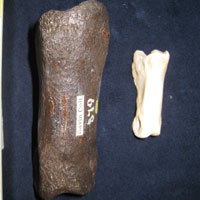
First phalanx of C. latifrons from the Forest Bed at Trimingham with the same bone of a recent red deer for size comparison
The extinct moose Cervalces latifrons, from the Middle and early Late Pleistocene of Eurasia, is the largest deer that ever existed. This title is usually attributed to the far more famous Irish elk, Megaloceros giganteus.
Megaloceros giganteus stags reached 1.8m in shoulder height while Cervalces latifrons could exceed 2.1m. However the antler span was greater in Megaloceros giganteus - up to 3.5m in the largest population from Ireland, and up to around 2.5m in Cervalces latifrons.
Cervalces latifrons and living moose are adapted to a similar diet, and lived in similar marshy habitats, with bushes and strewn debris.
Species detail
-

Taxonomy
Cervalces latifrons belongs to the deer tribe Alceini that includes the living moose species Alces alces. Find out what we know about the evolutionary relationships between different moose species.
-

Distribution
The Alceini group was widely dispersed across the Holarctic region. However it never reached southern Europe. Discover what fossil remains tell us about the habitat and eating habits of this group.
-

Biology
Moose living today are browsers and have particularly well-adapted teeth and muzzles to feed on their chosen plants. Cervalces latifrons displayed most of the same physical features. Discover what makes the moose’s legs so well suited to boggy terrain.
-

Behaviour
Unlike other deer, moose are solitary animals. Fossil remains suggest Cervalces lived alone, and that its antlers were for display rather than for male combat. Find out more about this extinct moose’s behaviour.
-

History of the type specimen
Johnson described a new species of deer in 1874, based on this specimen found on the Norfolk coast.
-
References
Get reference material for Cervalces latifrons.
Distribution map
A world map showing the distribution of Cervalces latifrons
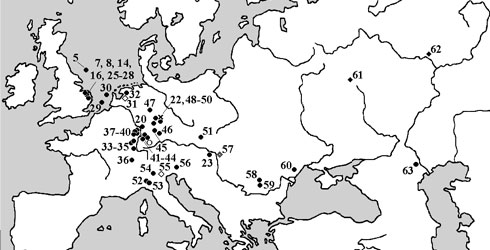
Map of the late Early Pleistocene to Late Pleistocene moose records in Europe
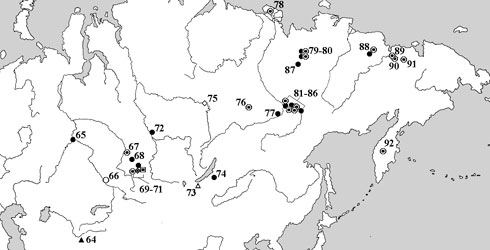
Map of the Cervalces records in Asia
Maps taken from: Systematical and biochronological review of Plio-Pleistocene Alceini (Cervidae; Mammalia) from Eurasia, Quaternary Science Reviews 24 (2005) 775–805, Marzia Breda and Marco Marchetti. View this paper for details of the locality numbers.
Images
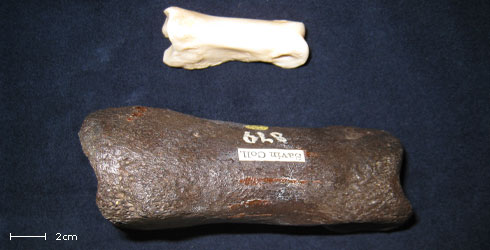
First phalanx of Cervalces latifrons from the Forest Bed at Trimingham, with the same bone of a recent red deer for size comparison.
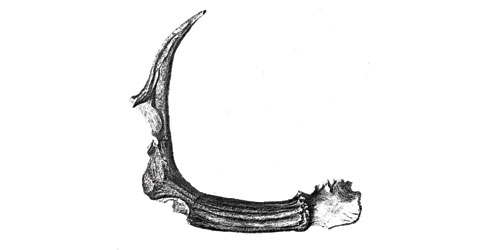
Holotype of Cervalces latifrons from Happisburgh, Forest Bed Formation, Norfolk coast.
© Original drawing by Johnson (1874).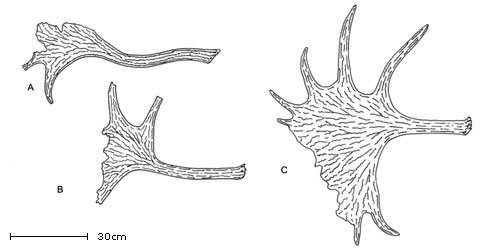
Line drawing of the best-preserved antler specimen of each of the 3 Cervalces species. A: C. gallicus from Seneze (France). B: C. carnutorum from Mosbach 1 (Germany). C: C. latifrons from Mosbach 2 (Germany).
© Drawing modified from Ravazzi 2003 - Gli antichi bacini lacustri e i fossili di Leffe, Ranica e Pianico Sellere
The Cervalces latifrons holotype was collected from the Forest Bed Formation at Happisburgh (Norfolk Coast between Cromer and Yarmouth) in the late 19th century by R Johnson.
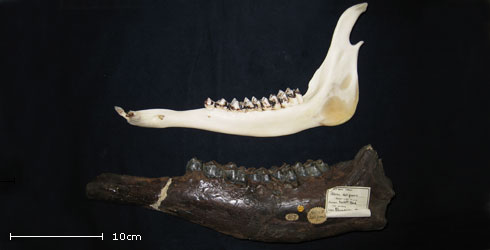
Left jaw of Cervalces latifrons from Mundsley (Forest Bed Formation, Norfolk, UK), with a recent red deer specimen for size comparison.
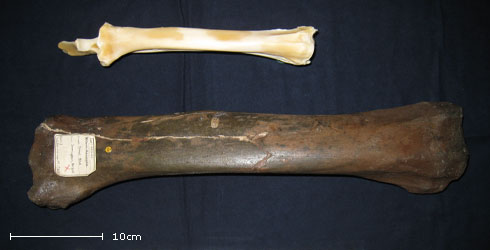
Right radius (forearm bone) of Cervalces latifrons from Trimingham (Forest Bed Formation, Norfolk, UK) with the same bone of a recent red deer specimen for size comparison.
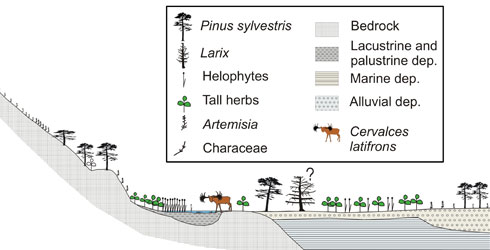
Palaeoenvironmental reconstruction along a topographic transect through Ranica (Bergamo region, Italy) at the time of Cervalces latifrons occupancy, as inferred by detailed pollen analysis of the sediment extracted from a moose skull.
Drawing modified from: Ravazzi 2003 - Gli antichi bacini lacustri e i fossili di Leffe, Ranica e Pianico Sellere.

Reconstruction of Cervalces latifrons antlers from Mosbach (Rheine Valley), at the Naturhistoriche Museum Maintz, Germany.
Author
Dr Marzia Breda
Marie Curie Fellow - deer palaeobiology
Department of Palaeontology
A word from the author
"I am in love with Cervalces since I came across it at the very beginning of my palaeontological career and it kept me busy for 3 long years, being the main topic of my PhD thesis. I think it is a truly majestic animal, wrongly forgotten, and that it would deserve a position in the public imagination among the other large mammals from the ice ages."
Toolbox
Glossary
Articular facet of the ungueal phalanx
Portion of the phalanx bearing the nails/claws which articulates to the previous finger/toe bones.
Chronospecies
A group of organisms that is derived from its ancestor (and/or develops into its descendant) by a process of slow, steady, evolutionary change and is not regarded as a member of the same species as its ancestor and/or descendant.
Cuneiforms
Bones of the ankle.
Ethology
Scientific study of animal behaviour.
Forbs
Herbaceous flowering plants that are not graminoids (grasses, sedges and rushes). The term is used in vegetation ecology to represent a guild of grassland plant species with broadly similar growth form, which in ecology is often more important than taxonomic relationship.
Holotype
The single specimen designated by an author to formally describe a new species.
Navico-cuboid
Main bone of the ankle of Ruminant animals.
Non-gregarious
Non-social, solitary
Metapodials
Hand and foot bones between the fingers/toes and the wrist/ankle.
Palustrine
Living in a marsh or swamp.
Phalanges
Bones of the fingers and toes.
Phyletic lineage
Ancestor-descendent populations that undergo morphological change over time.
Telmatic vegetation
Vegetation living in the swamp zone of a lake developing into a bog.
